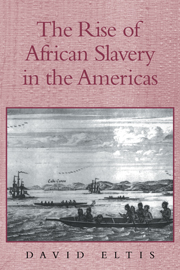Book contents
- Frontmatter
- Contents
- List of Tables
- List of Maps
- Preface
- Abbreviations
- Chapter 1 Slavery and Freedom in the Early Modern World
- Chapter 2 The English, the Dutch, and Transoceanic Migration
- Chapter 3 Europeans and African Slavery in the Americas
- Chapter 4 Gender and Slavery in the Early Modern Atlantic World
- Chapter 5 Productivity in the Slave Trade
- Chapter 6 Africa and Europe in the Early Modern Era
- Chapter 7 The African Impact on the Transatlantic Slave Trade
- Chapter 8 The English Plantation Americas in Comparative Perspective
- Chapter 9 Ethnicity in the Early Modern Atlantic World
- Chapter 10 Europe and the Atlantic Slave Systems
- Epilogue on Abolition
- Appendices
- A The Age and Sex of Africans in the Transatlantic Slave Trade, 1663–1713
- B Slave-Price Appendix
- C Merchandise Imported to West Africa, 1662–1713
- D Valuations of Produce Exports from the Leeward Islands in 1700
- Maps
- Sources and Bibliography
- Index
A - The Age and Sex of Africans in the Transatlantic Slave Trade, 1663–1713
Published online by Cambridge University Press: 05 August 2012
- Frontmatter
- Contents
- List of Tables
- List of Maps
- Preface
- Abbreviations
- Chapter 1 Slavery and Freedom in the Early Modern World
- Chapter 2 The English, the Dutch, and Transoceanic Migration
- Chapter 3 Europeans and African Slavery in the Americas
- Chapter 4 Gender and Slavery in the Early Modern Atlantic World
- Chapter 5 Productivity in the Slave Trade
- Chapter 6 Africa and Europe in the Early Modern Era
- Chapter 7 The African Impact on the Transatlantic Slave Trade
- Chapter 8 The English Plantation Americas in Comparative Perspective
- Chapter 9 Ethnicity in the Early Modern Atlantic World
- Chapter 10 Europe and the Atlantic Slave Systems
- Epilogue on Abolition
- Appendices
- A The Age and Sex of Africans in the Transatlantic Slave Trade, 1663–1713
- B Slave-Price Appendix
- C Merchandise Imported to West Africa, 1662–1713
- D Valuations of Produce Exports from the Leeward Islands in 1700
- Maps
- Sources and Bibliography
- Index
Summary
Sex and age characteristics exist for 111,323 Africans carried across the Atlantic or close to more than one-tenth of all Africans who left for the Americas on British ships between 1663 and 1714. Traders took these slaves from every major African region involved in the traffic at this time, except for southeast Africa, and carried them to mainly Caribbean destinations on a total of 432 ships – 361 operating from English ports, 46 from Dutch, 22 from Danish, and 3 from French. The sample is thus large and well distributed. The major bias is the lack of observations for Brazil and the fact that the English slave trader and the English Caribbean are overrepresented. However, it is likely that the English carried more slaves than all other nationalities combined in these years and that the English Americas absorbed more slaves than all other transatlantic regions. Mean number of Africans per ship in the sample is 257.7 (s.d. = 152.3).
Three preliminary comments are called for. The counts of men, women, and children or males and females included in the sample were sometimes made before the ship began its journey, sometimes at the point of arrival or point of sale, and sometimes at all three locations. The possibility arises that mortality between these points was age- or sex-specific and that demographic ratios on board ships leaving Africa would not be the same as on those arriving or sold in the Americas.
- Type
- Chapter
- Information
- The Rise of African Slavery in the Americas , pp. 285 - 292Publisher: Cambridge University PressPrint publication year: 1999



